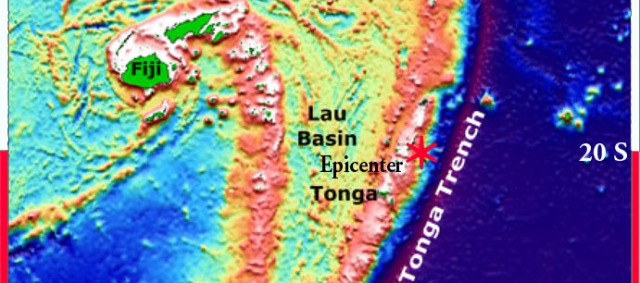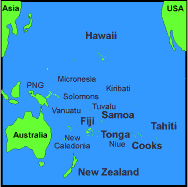
March 31, 2011 – WAILAGI LALA, FIJI (BNO NEWS) — A strong earthquake struck the South Pacific Ocean on early Thursday afternoon, not far from an island part of Fiji, seismologists said. No tsunami warnings were issued. The 6.4-magnitude earthquake at 12.11 p.m. local time (0011 GMT) was centered about 130 kilometers (80 miles) east of Wailagi Lala, the northernmost outpost of Fiji’s Lau Islands with no known population. It struck about 23.7 kilometers (14.7 miles) deep, making it a shallow earthquake, according to the United States Geological Survey (USGS). The USGS estimated that 2,000 to 3,000 people in the region may have noticed weak to light shaking, but said no damage was to be expected. “There is a low likelihood of casualties and damage,” the agency said. The Pacific Tsunami Warning Center did not issue a tsunami warning. –Channel 6 News





 This is the 7th quake to strike Fiji in a week. This is more evidence that our preliminary assessment of volcanic and seismic activity along the volcanic trench of Tonga-Kermadec in the subduction zone has been in a period of escalation for the last 3 months. The Tonga Trench in the South Pacific Ocean is 10,882 meters (35,702 ft) deep at its deepest point which is known as the Horizon Deep. Under the sea, the Pacific Plate is being subducted below the Tonga and the Indo-Australian Plate. In this transform fault zone, where plates also slide in horizontal fashion, the convergence is taking place at a rate estimated at approximately 15 centimeters (6 inches) per year; however, recent Global Positioning Satellite measurements indicate in places a convergence of up to 24 centimeters (10 inches) per year is occurring across the northern Tonga Trench. This is the fastest plate velocity recorded on the planet. This results in the earth’s most active zone of mantle seismicity, where mantle is essentially devoured and recycled. This process takes place under both tremendous heat and pressures. The escalation of seismic activity in this region, Tonga, New Zealand, Kermadec may be one more indication also that geothermal gradient is increasing. The Fiji quake and resulting stress on the Pacific Plate was almost immediately followed by yet another 6.2 earthquake off the eastern coast of Japan. The Pacific Ring of Fire is becoming more volatile and dangerous and this seismic dynamism continues to perturb the stability of surrounding plates in the region. –
This is the 7th quake to strike Fiji in a week. This is more evidence that our preliminary assessment of volcanic and seismic activity along the volcanic trench of Tonga-Kermadec in the subduction zone has been in a period of escalation for the last 3 months. The Tonga Trench in the South Pacific Ocean is 10,882 meters (35,702 ft) deep at its deepest point which is known as the Horizon Deep. Under the sea, the Pacific Plate is being subducted below the Tonga and the Indo-Australian Plate. In this transform fault zone, where plates also slide in horizontal fashion, the convergence is taking place at a rate estimated at approximately 15 centimeters (6 inches) per year; however, recent Global Positioning Satellite measurements indicate in places a convergence of up to 24 centimeters (10 inches) per year is occurring across the northern Tonga Trench. This is the fastest plate velocity recorded on the planet. This results in the earth’s most active zone of mantle seismicity, where mantle is essentially devoured and recycled. This process takes place under both tremendous heat and pressures. The escalation of seismic activity in this region, Tonga, New Zealand, Kermadec may be one more indication also that geothermal gradient is increasing. The Fiji quake and resulting stress on the Pacific Plate was almost immediately followed by yet another 6.2 earthquake off the eastern coast of Japan. The Pacific Ring of Fire is becoming more volatile and dangerous and this seismic dynamism continues to perturb the stability of surrounding plates in the region. –






I have a question concerning the plutonium in the ground in Japan. if it rains the water will becoe polluted, right? if so, when it is sucked back into the clouds by the sun, and it rains over a populated area wil there be any possibility of getting plutonium attacked, so to speak?
As for the quakes. if i remember my history correctly, the vast continent of Lemuria used to be where the Pacific is now. since most of these recent quakes have been mostly sub-duction quakes, wouldn’t that mean the long underwater earth is rising toward the survice. plus the inundation of the lowlands in the Phillipines, Thailand, and others doesn’t mean they are lowering ,it just means the ocean is being forced to rise by the rising of the earth beneath? tks
LikeLike
What’s in the Earth will likely stay there. Though evaporation and radioative steam in the air does create poisonous rainfall. The search for what was known as Lemuria is on-going.
LikeLike
Thanks for keeping us so informed Alvin. You do a great job and your stories as always are of great interest. Not looking good for N.Z. or the other Pacific Islands,what are you thoughts on this? What would be your guess on when the Alpine Fault in New Zealand might go off? Thanks.
LikeLike
Bundy, you’re welcome. I think intensified seismic action along the Alpine fault will be preceded by heavy volcanic activity along the Tonga-Kermadec Trench. When we start to see an inordinate amount of quakes and volcanic eruptions happening, we may know that the magmatic pressures are exerting tremendous forces on this rather unique geological zone.
LikeLike
how does all this seismic activity affect Fiji?
LikeLike
We’ll see Felix…right now its considered a potential volcanic hotspot
LikeLike